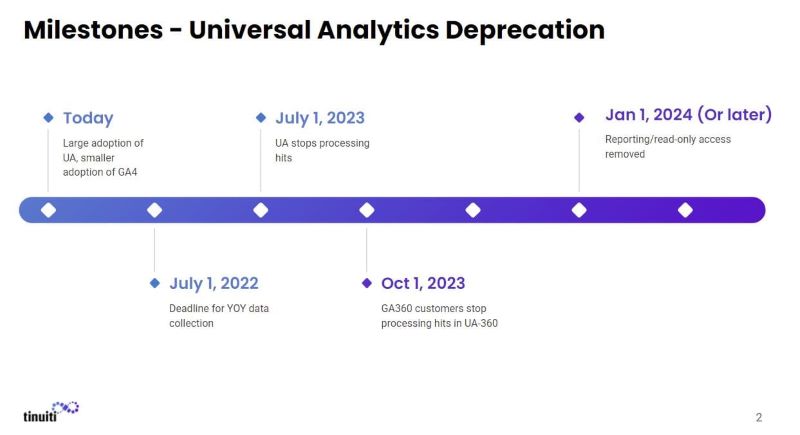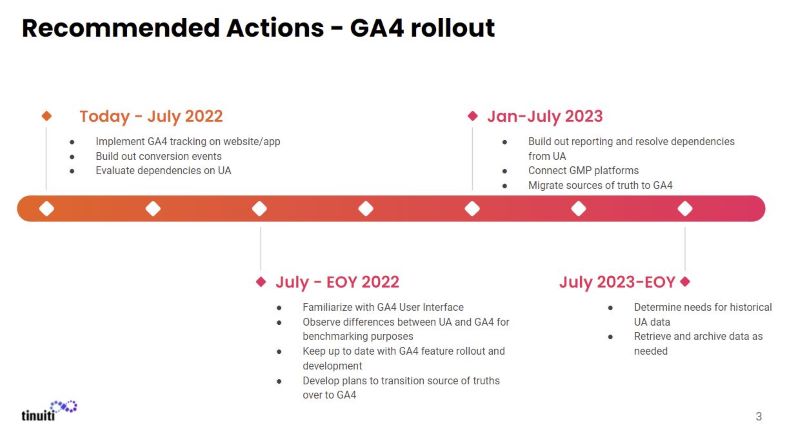Google Announces Universal Analytics Sunsetting Date

Google has officially announced plans to sunset their popular Universal Analytics (UA) platform on July 1, 2023. GA360 properties will be given a three-month extension, and will stop processing hits on October 1, 2023. The previously processed data within your Universal Analytics properties will be accessible for at least six months; Google plans to “provide a future date for when Universal Analytics properties will no longer be available” in coming months. The successor to Universal Analytics, pre-released as App + Web beta, was fully released as Google Analytics 4 (GA4) in October 2020.
Knowing that UA deprecation was eventual given the launch of GA4, many brands and businesses have already added GA4 to their sites, as a GA4 property can be created without removing Universal Analytics.
But for those reading who haven’t yet added GA4 to their website, the time to do so is now. (And yes…Tinuiti can help!)
“If companies have not yet started tracking within a GA4 property, the time is running out. While Universal Analytics deprecation is a little over a year away, brands will need to collect data NOW in order to have valid year-over-year comparisons when the old platform is shut off.”

— Tom Clinton, Director of Engineering & Web Analytics at Tinuiti

In this post, we’ll take a closer look at what GA4 is, how it differs from UA, and why you should consider June 30, 2022 your absolute cutoff date for getting GA4 added to your site.
Google announced a limited beta release of Universal Analytics in October 2012, kicking off with “large enterprises, such as Premium customers and those who want to work with APIs.” The platform was expanded into public beta a few months later in March 2013, and as the saying goes…the rest is history.
The successor to Classic Analytics, the necessity for Universal Analytics (UA) was largely driven by a sharp increase in cross-device usage, and a more complex internet—and ways of using the internet. Technology, and the role it played in our daily lives, was advancing quickly; as more people ‘went online’ beyond the tethers of their desktop, Classic Analytics wasn’t equipped to paint a full enough picture of the viewer journey.
Fast-forward to today, and the specifics of the change are different, but the underlying reason is much the same. The internet of 2022 is very different from the internet of 2012, and the picture GA4 paints is quite different from UA’s. GA4 is built for the privacy-focused future that isn’t so reliant on cookies, and we’re excited to see how its capabilities and the unique insights it provides continue to grow over time.
“GA4 is the newest generation of the popular Google Analytics web and app tracking platform that accommodates an increasingly cookieless and privacy-first future.”
— Tom Clinton, Director of Engineering & Web Analytics at Tinuiti
Top takeaways about GA4:
Check out our blog post What is Google Analytics 4, and Why Should You Implement it ASAP? for more details about the platform.
Simply put, no—this is not a refresh or generational change of the existing platform; it presents an entirely new way of looking at things.
“There are a number of methodological differences in GA4 vs. Universal Analytics that prevent reliable use of UA/GA4 comparisons, even if the metrics are named the same between the two platforms.”

— Andrew Richardson, SVP of Analytics & Marketing Science at Tinuiti
As Andrew notes above, even metrics bearing the same name across GA4 and UA don’t provide an ‘apples-to-apples’ comparison. Using “events” as an example, because the criteria used to define an event in UA differs from the criteria used to define an event in GA4, the two can’t be reliably compared.
“Universal Analytics is only as good as the signals it’s using, which are already starting to go away. GA4 is poised for the future, with a primary goal of ensuring the measurement of your advertising dollars, and your website performance, is the best it can be.”

— Tom Clinton, Director of Engineering & Web Analytics at Tinuiti
A separate tracking code needs to be added to all web properties. If you are already using Google Tag Manager (GTM) successfully, this can be done within existing GTM integrations, with no immediate need for code development. If you aren’t currently using GTM, you will need to upgrade your site from analytics.js to gtag.js. We recommend considering Tag Manager if this is the case, as it provides ease of implementation for all site tags, not just Analytics.
Many of our teams and brands rely heavily on data-driven attribution, which will be the default in GA4.
“Conversion modeling powered by machine learning allows you to preserve measurement even when cookies or other identifiers aren’t present. Data-driven attribution in Google Ads takes this a step further. It uses advanced machine learning to more accurately understand how each marketing touchpoint contributed to a conversion, all while respecting user privacy.”
— Vidhya Srinivasan, VP/GM Buying, Analytics and Measurement, Google Ads
Prior to data-driven attribution, Google Ads default model was last, non-direct click attribution. This model attributes all ‘credit’ for a sale/conversion to whichever ad (and corresponding keyword) a viewer last clicked before converting.
The last-click attribution model is popular, but flawed; while it does consider which ad effectively ‘closed the deal,’ it doesn’t give any credit to the influence other ads had in the consumer journey that built up to the sale—or the non-ad-specific initiatives aimed at increasing awareness and overall visibility.

Many of our clients rely on Google Analytics data as their source of truth, and we know they aren’t alone. BuiltWith data shows that at least one version of Google Analytics is used by at least ~28 million websites today.
Preparing for the deprecation of UA by installing GA4 today is made even more important by how many brands—and by extension, advertisers—rely on that data in making very impactful choices. Having reliable, apples-to-apples, year-over-year data is crucial in making key business decisions, understanding how your site is performing, and knowing what to advertise, and how effective that advertising is.
Ready to add GA4 to your site, but don’t have the internal resources or bandwidth to get it set-up? We can help! Our Analytics team understands how important accurate YoY data is when making key business decisions, and building your advertising campaign strategies.
We are equipped to help existing and new clients get GA4 quickly, properly added to their site so they can begin pulling in data. Installing GA4 as soon as possible will give your team more time to familiarize themselves with the platform, and how to most effectively use the data within, while UA is still available. Tinuiti can quickly implement basic tracking for a small fee, as well as customized conversion/goal tracking.
In addition to getting GA4 added to your site, we also offer the option for clients to utilize Mobius as a place that can “combine” UA and GA4 data into a single view.
Mobius has the ability to pull and store data from both Universal Analytics and Google Analytics 4. As we noted above, GA4 and UA data does not offer a 1:1 comparison; however, Mobius can handle the heavy lifting of exporting and storing your data in a central location for your historical and go-forward reference.
Want to learn more about GA4, and how Tinuiti’s Analytics experts can get your site properly set-up for future measurement success? Reach out today!
